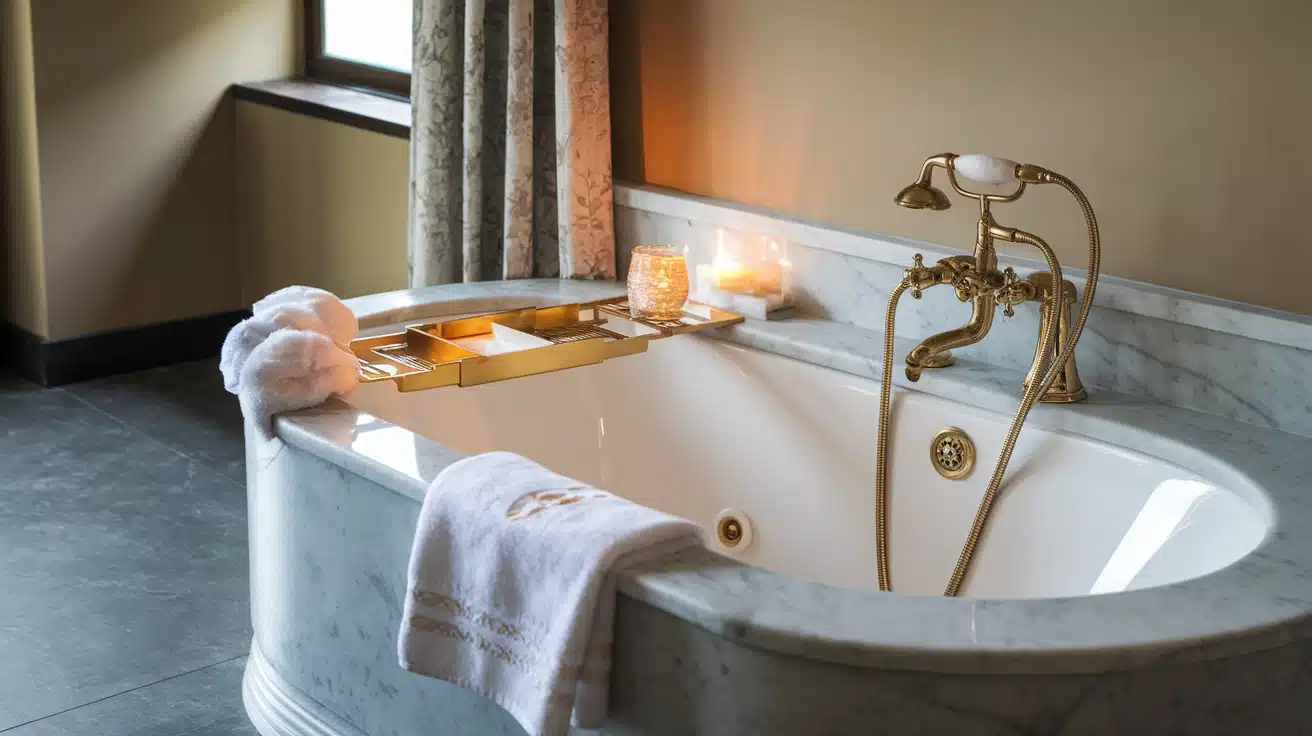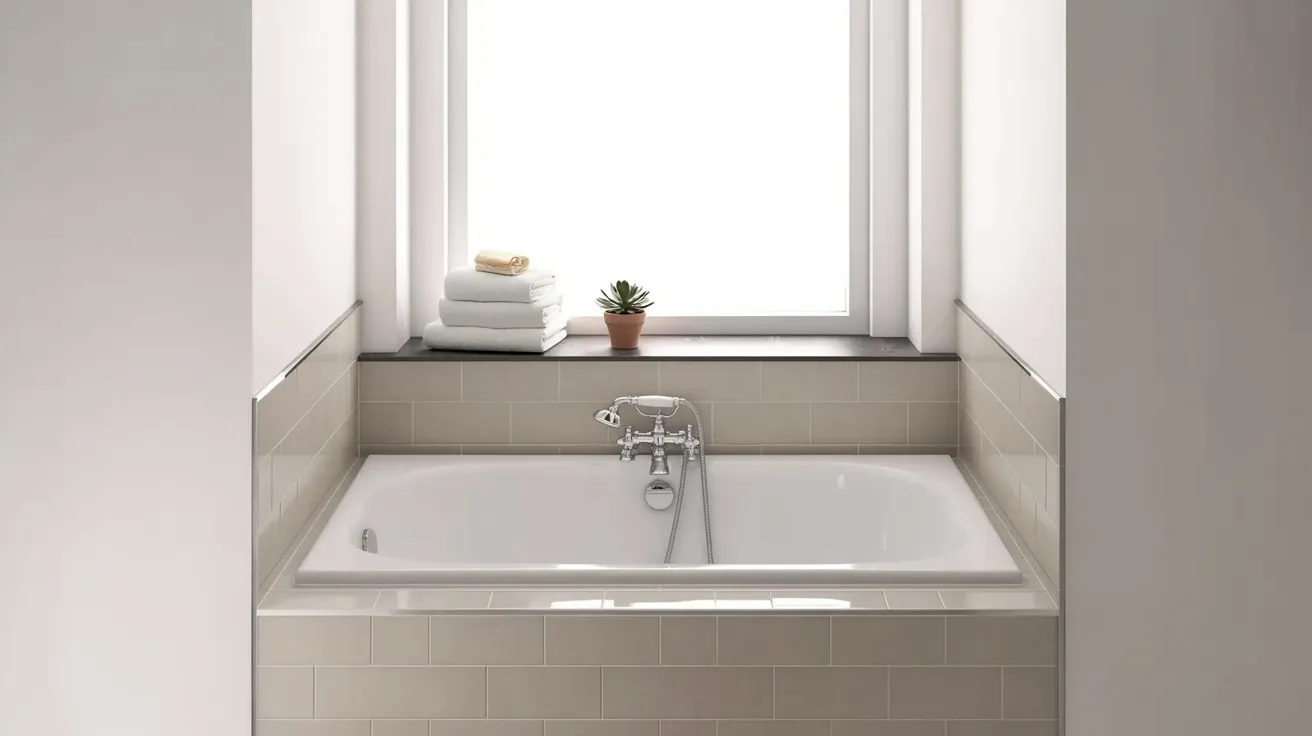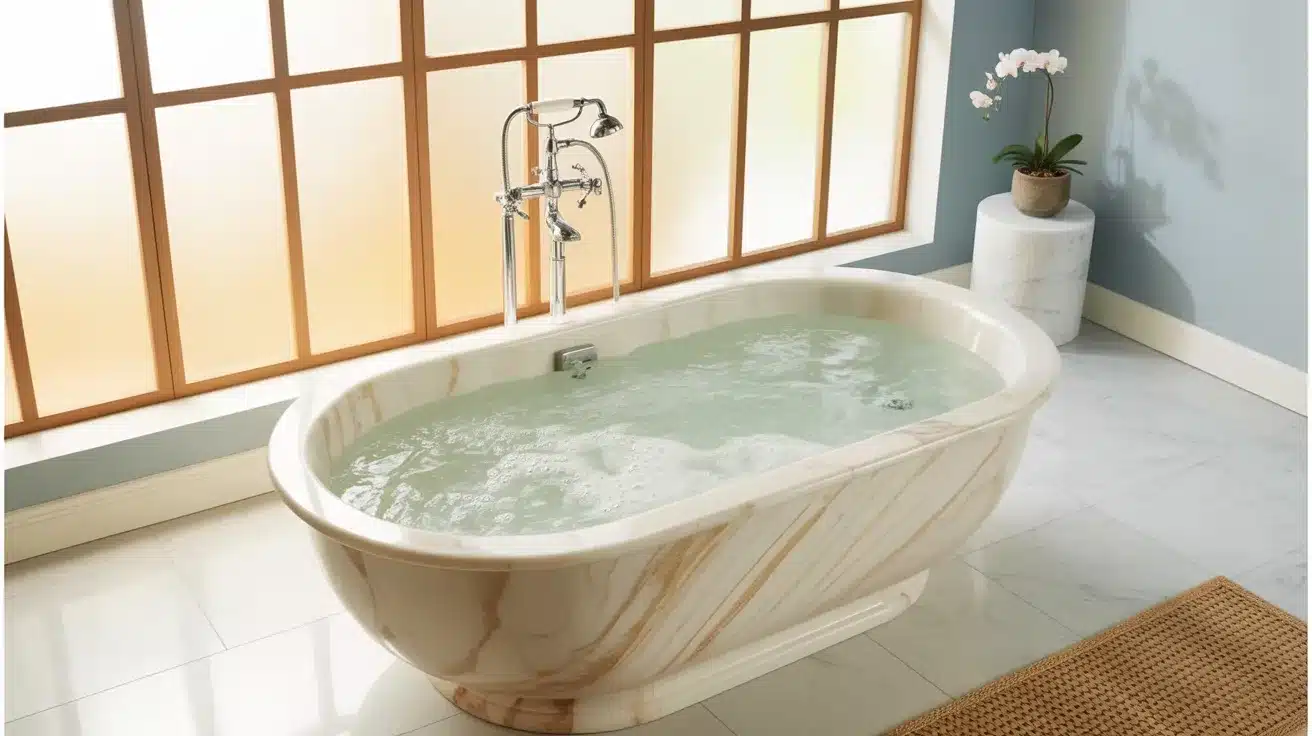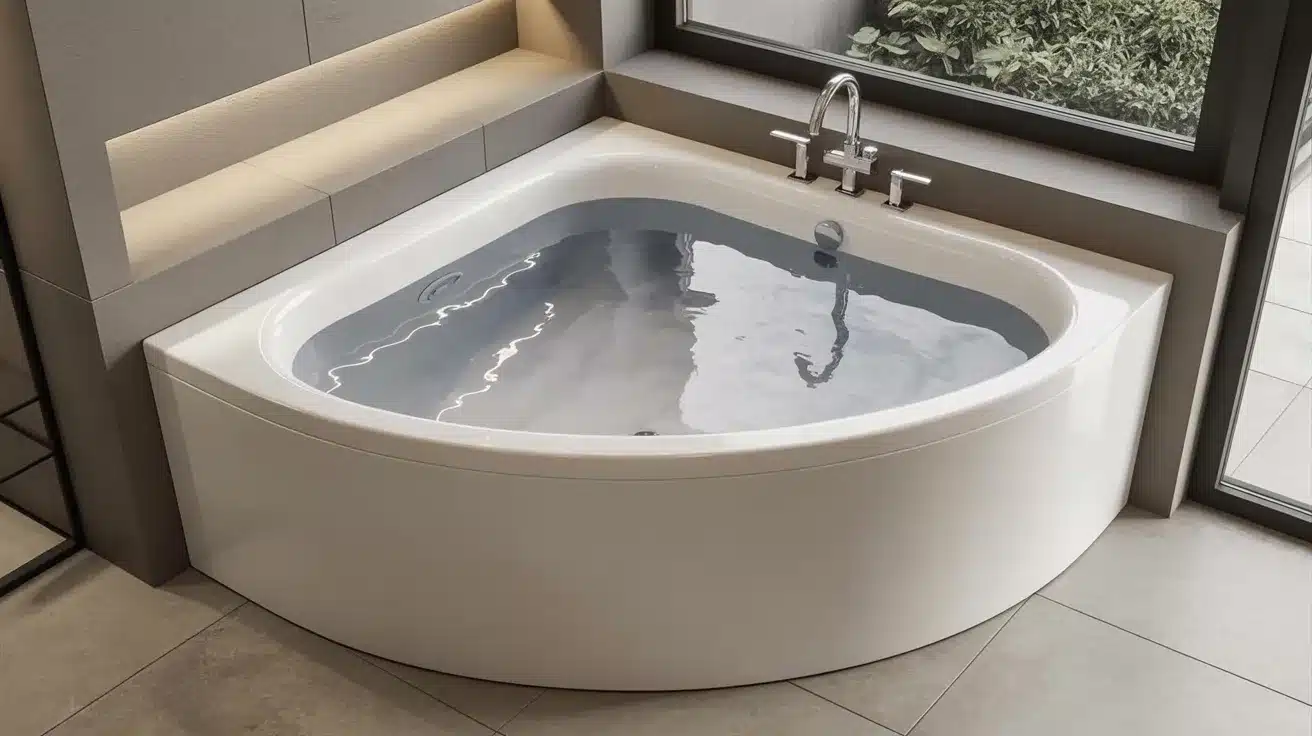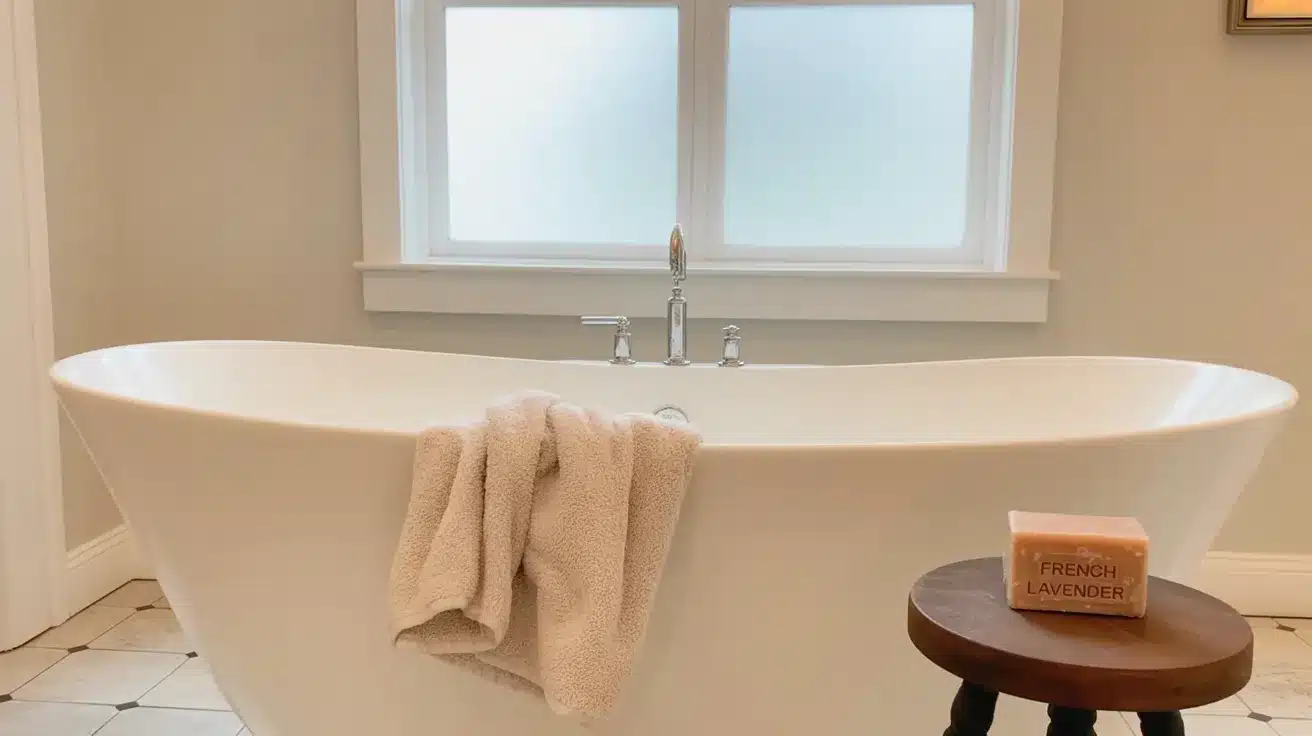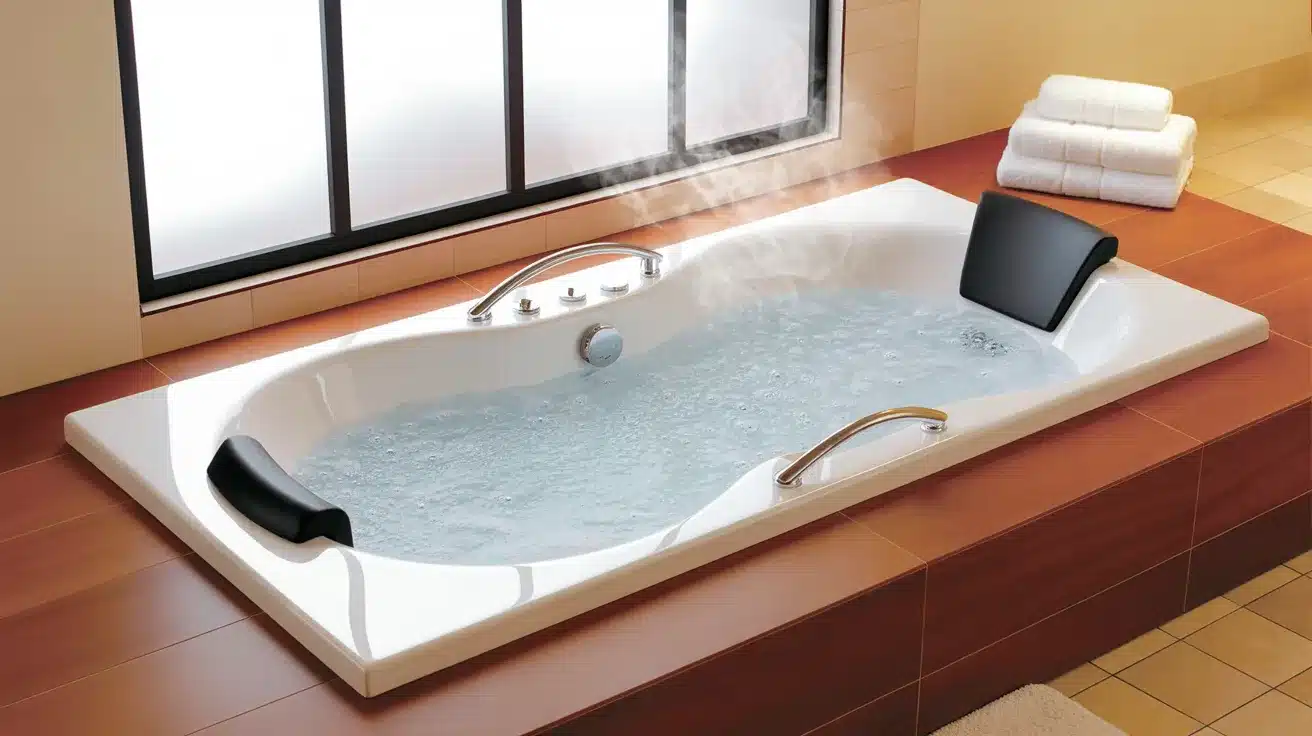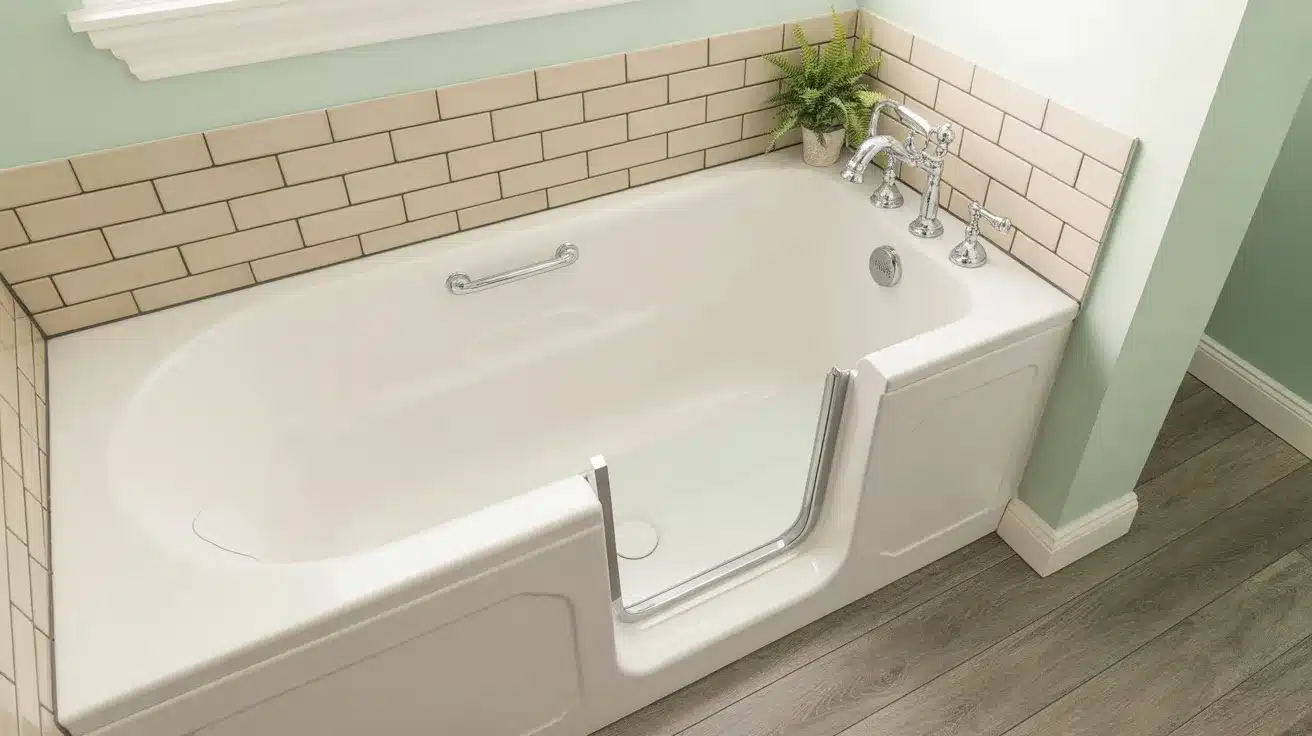Most homeowners waste thousands of dollars on bathtubs that don’t fit their space or needs. You step into your new tub only to find your knees pressed against the walls or empty floor space mocking your poor choice.
What if you could avoid this costly mistake? The secret lies in understanding how bathtub dimensions work with your specific bathroom layout and daily habits.
Imagine soaking comfortably in a tub that fits your body perfectly while making your bathroom feel more spacious. Picture bath time becoming your favorite part of the day instead of a cramped struggle.
Keep reading to learn the exact measurements, types, and selection process that will help you choose the perfect bathtub size for your space and lifestyle.
How Bathtub Size Affects Comfort and Functionality
Selecting the right bathtub size affects your daily comfort and bathroom function. The wrong size can make your space feel cramped or leave you uncomfortable during baths.
- Comfort comes first: A tub that’s too small won’t let you relax properly. Your knees might hit the sides, or you may not be able to stretch out fully. The right size lets you soak comfortably without feeling restricted.
- Space planning: Your bathroom has limited square footage. A bathtub that’s too large can overwhelm the room and restrict movement. Too small, and you waste valuable floor space that could serve you better.
- Function follows form: Different household members have different needs. Tall people need longer tubs. Families with small children benefit from wider models for bath time safety.
Standard Sizes for Each Type of Bathtub
Compare standard dimensions across different bathtub types to find the right fit for your space. This quick reference shows typical measurements for each style, helping you plan your bathroom layout effectively.
| Bathtub Type | Length (inches) | Width (inches) | Height (inches) |
|---|---|---|---|
| Standard Alcove | 60 | 30-32 | 14-20 |
| Freestanding | 61-68 | 27-32 | 15-20 |
| Whirlpool | 60-72 | 32-36 | 18-24 |
| Corner | 48-72 | 48-72 | 18-24 |
| Soaking | 45-60 | 30-36 | 24-28 |
| Walk-In | 52-60 | 28-32 | 38-47 |
Sizes may vary by manufacturer. Always check specific product dimensions before making final decisions. Most measurements include standard depths of 14-20 inches unless noted otherwise.
Different Types of Bathtubs
Choosing the right bathtub size depends on your bathroom space and personal needs. Each type offers unique benefits for different layouts and preferences.
1. Alcove Bathtubs
Alcove bathtubs are designed to fit in a three-walled enclosure, with the back and sides resting against walls. They are the most common type for bathrooms with limited space.
- Space Efficiency: Ideal for smaller bathrooms as they fit neatly into corners or alcoves.
- Shower Combo: These tubs often come with an option to combine a shower, making them versatile for those who need both a bath and a shower.
- Material: Common materials include acrylic or fiberglass, which are lightweight and cost-effective.
- Accessibility: Often come in standard sizes, but can also be customized for more accessible designs.
2. Freestanding Bathtubs
Freestanding bathtubs are not attached to any walls or other structures and are designed to stand alone. These bathtubs can be placed anywhere in the bathroom, offering flexibility in terms of placement and design.
- Material: Common materials include acrylic, cast iron, stone, or copper. Each material offers different benefits, such as durability or visual appeal.
- Design: Freestanding tubs come in various shapes, including oval, round, square, and rectangular, catering to different design preferences.
- Installation: Freestanding tubs often require more space and can be installed with a floor-mounted or wall-mounted faucet.
- Visual Appeal: Known for adding a luxurious or vintage feel to a bathroom due to their standalone nature.
3. Corner Bathtubs
Corner tubs are designed to fit in the corner of a bathroom, often with a triangular or rounded shape. They are space-efficient and offer a unique design that maximizes available bathroom space.
- Space Efficiency: Ideal for smaller or irregularly shaped bathrooms where optimizing space is essential.
- Comfort: Some corner tubs come with built-in seating or ergonomic shapes that provide extra comfort during bath time.
- Design: Typically comes in a corner-friendly triangular shape, though other styles are also available.
- Size: Often larger than standard bathtubs but still efficient in terms of space usage.
4. Soaking Tubs
Soaking tubs are designed for deep, comfortable baths. They are typically deeper and allow for full-body immersion, offering a more relaxing bath experience.
- Depth: These tubs are designed to allow for a deeper soak compared to standard tubs, often with a higher wall to increase water depth.
- Comfort: Soaking tubs are often ergonomically designed with a contoured shape to enhance comfort during the bath.
- Materials: Can be made from various materials, including acrylic, stone, and cast iron.
- Therapeutic Use: Especially beneficial for stress relief, relaxation, and muscle recovery.
5. Whirlpool Tubs
Whirlpool tubs feature jets that provide a massaging effect, allowing for a relaxing and therapeutic experience. They are popular in luxury bathrooms or spa-like settings.
- Massage Jets: Incorporate air or water jets that create a soothing massage experience, with adjustable speeds and directions.
- Therapeutic Benefits: The jets can help with muscle relaxation, stress relief, and overall well-being.
- Installation: Often installed in larger bathrooms due to their size and the need for plumbing connections.
- Materials: These tubs are usually made from acrylic or fiberglass to keep the weight manageable, although high-end models can feature stone or other premium materials.
6. Walk-In Tubs
Walk-in bathtubs are designed for accessibility, featuring a door that allows the user to walk into the tub without having to climb over a high side. They are ideal for the elderly or individuals with disabilities.
- Accessibility: Features such as a low entry step, grab bars, and a watertight door allow for easy entry and exit.
- Safety Features: Equipped with non-slip floors, handrails, and anti-scald features to enhance user safety.
- Therapeutic Benefits: Many walk-in tubs feature whirlpool or air jets, providing a therapeutic bath experience.
- Materials: Made from durable acrylic or fiberglass, designed for easy maintenance and to prevent mold growth.
How to Choose the Best Bathtub Size for Your Space
Find Your Perfect Bathtub Size with This Quick Quiz. Answer Four Simple Questions to Get a Personalized Recommendation Based on Your Space and Needs.
Question 1: What is your bathroom size?
A) small (less than 40 Sq Ft)
B) medium (40-60 Sq Ft)
C) large (60-100 Sq Ft)
D) master (over 100 Sq Ft)
Question 2: How Do You Primarily Use Your Bathtub?
A) quick Showers Only
B) occasional Baths
C) regular Soaking
D) daily Long Baths
Question 3: What Is Your Household Situation?
A) single Person or Couple
B) small Family with Kids
C) growing Family
D) Empty Nesters or Luxury Seekers
Question 4: What Is Your Budget and Design Preference?
A) budget-conscious
B) mid-Range
C) higher Budget
D) luxury Focus
Your Bathtub Size Recommendation
Mostly A’s: Compact Alcove Tub (60″ X 30″)
Best For: apartments, Guest Bathrooms, First-Time Homeowners
Key Benefits: affordable, Easy Installation, Widely Available
Mostly B’s: Standard Soaking Tub (60″ X 32″)
Best For: family Bathrooms, Everyday Luxury, Balanced Needs
Key Benefits: more Soaking Space, Fits Most Bathrooms, Good Value
Mostly C’s: Large Soaking or Corner Tub (66″ X 36″)
Best For: master Bathrooms, Frequent Bathers, Growing Families
Key Benefits: room to Stretch, Deeper Soaking, Multiple Users
Mostly D’s: Luxury Freestanding Tub (72″ X 36″)
Best For: master Suites, Luxury Renovations, Daily Bath Lovers
Key Benefits: Spa experience, design statement, ultimate comfort
Best Bathtub Materials for Cleaning and Longevity
Choosing the right bathtub isn’t just about size and style—it’s also about long-term care. Different materials offer varying levels of durability, maintenance effort, and ease of cleaning.
Below is a quick guide comparing common bathtub materials to help you decide what best fits your lifestyle.
| Material | Ease of Cleaning | Maintenance Needs | Durability |
|---|---|---|---|
| Acrylic | Easy – smooth, non-porous surface | Low – occasional polishing to prevent dulling | Moderate – can scratch |
| Fiberglass | Very easy – lightweight and smooth | Moderate – prone to fading/cracking over time | Lower – less durable |
| Cast Iron | Moderate – heavy but glossy enamel | Low – long-lasting finish, resists staining | Very high – extremely durable |
| Stone Resin | Easy – stain-resistant surface | Low – needs gentle cleaners to avoid dulling | High – solid and strong |
| Copper | Moderate – needs regular waxing | Medium – can tarnish, requires upkeep for shine | High – naturally antimicrobial |
Your bathtub should enhance your space—not add to your cleaning routine. By selecting a material that matches your maintenance preferences and durability needs, you’ll ensure years of comfort and visual appeal.
Use this guide as a foundation for choosing a tub that’s both practical and long-lasting.
Conclusion
Now you have all the tools to make an informed decision about the size of your bathtub.
From understanding standard dimensions to taking our quiz, you know exactly what works for your space and lifestyle.
Each tub type serves different needs: alcove for tight budgets, freestanding for luxury, and corner for smart space usage.
The key is matching your bathroom’s square footage with your family’s bathing habits. Don’t rush this choice. A well-sized tub becomes the foundation of your daily routine for years to come.
Start by measuring your current space and noting what frustrates you most about your existing setup. Then use our size guide to find your ideal match.

